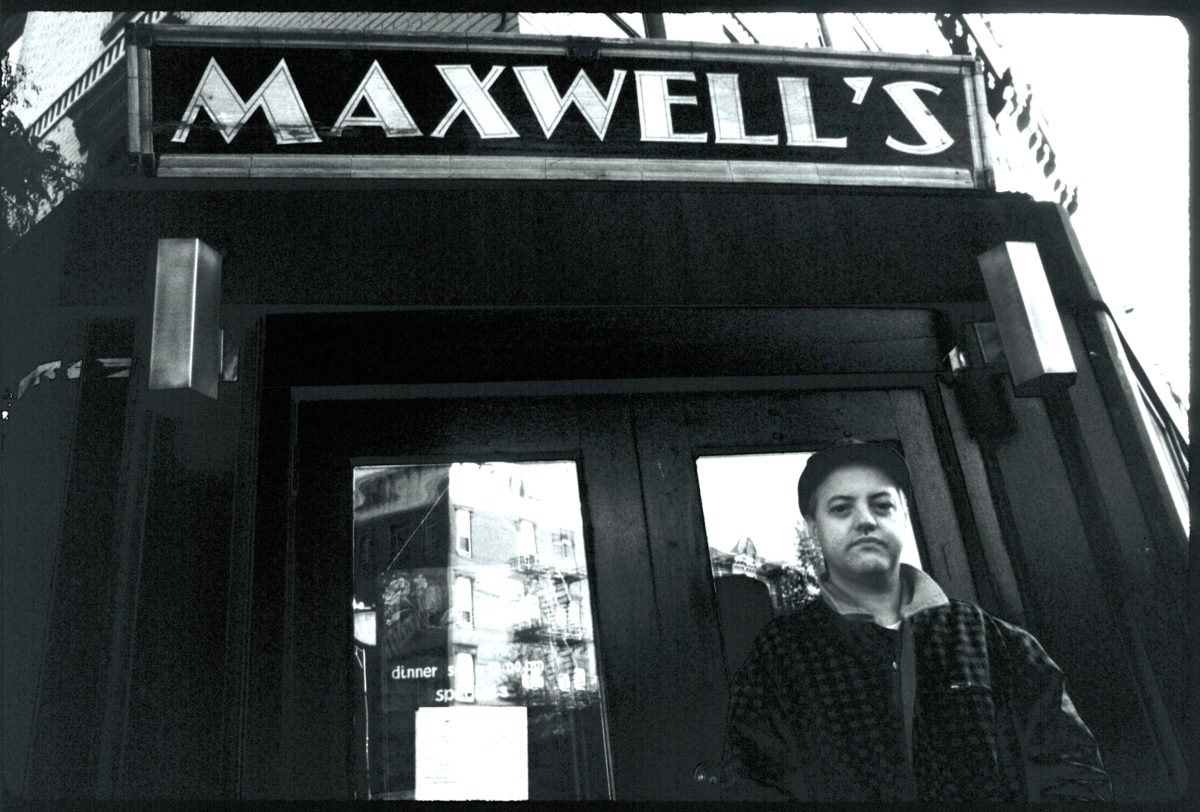
I moved into a derelict apartment in Hoboken, New Jersey in the early 90s, an escape hatch from the mundane suburbs. It was $275 a month for a dank basement room, but it didn’t matter—I could be in downtown Manhattan in a half hour. Back then, Hoboken was still accessible enough to allow artists and musicians and writers to inhabit the mini metropolis. Somehow I managed to score a bartending job at Maxwell’s, the famed independent music venue and pub founded by Steve Fallon in the late ‘70s. I basically walked in one afternoon asking if they were hiring and Steve told me to pour a draft beer and then hired me on the spot. I was a mostly directionless twenty two-year old, but I knew how to pour a beer.
Maxwell’s was where I became a person. I worked with (and served) a ragtag crew of eccentrics, some of whom became close friends. I made a solid wage behind the bar and got to see killer shows most nights. The place had a certain magic to it. If you saw bands play (or if you played in a band) at Maxwell’s back in the day, you know what I mean. You know that it was an institution. And you know that the schlep into Hoboken—either wrestling for a parking spot or braving the lengthy trek up Washington Street from the PATH—was well worth it.
To pay homage to Maxwell’s, I collected the following memories from an eclectic group of musicians who played there before the venue shut in ‘2013. We miss you, Maxwell’s.
—Frances Badalamenti
What is your quintessential memory of Maxwell’s?
WILL OLDHAM: At the beginning of ‘86, I went to NYC to see my friends in Squirrel Bait play a few shows over a weekend. My friend Steve [Driesler] and I flew into Newark and went straight to Hoboken, where a Louisville contingent had been living in recent years. The first show of the weekend was to be Squirrel Bait and Dinosaur at Maxwell’s. This was before Dinosaur had to change their name to Dinosaur Jr. I was a week or two away from turning sixteen. Not sure if that means I had to sneak into Maxwell’s or not. Hoboken didn’t feel hip. I was made aware that it was a city in transition from a t-shirt I saw on someone that said, “I Remember Hoboken When Hoboken Was Hoboken.” The Dinosaur set was the loudest I had witnessed up to that point; it made my head hurt from the inside. The venue felt cozy and welcoming.
BOB NASTANOVICH: In ’91 and ’92, I lived a few hundred feet from Maxwell’s on Washington Street in Hoboken. Coincidentally, I rented an apartment and the previous tenant was Bob Mould. It was dark on the sidewalk just outside of the performance room. Through the shaded window, you could get a glimpse of the bands and hear them pretty well there. It was a free preview and I used to surreptitiously drink beer back by the dumpster. I went in for many shows as a paid customer. The Mekons, at the peak of their powers, were justifiably adored there. They would ram the place. Nearing the end of the only set I saw them play there, I slipped out to enjoy one of my hidden beers and to get a breath of fresh air. It was more convenient and cheaper than waiting at the bar. There was a thin fellow with long brown hair mumbling to himself in a maniacal way that he needed to speak with Jon Langford [of The Mekons]. As a natural comforter of the deranged, we conversed. I told the guy that I imagine Jon Langford is a nice guy and that their set was nearly over. He couldn’t wait. He reached into the dumpster and yanked out a large piece of a discarded tailpipe assembly from an unfortunate car. Quickly, he threw it through the large window. It was sudden and mayhem ensued. The guilty party sprinted north and rounded the corner. Taken aback, I froze. I remember Bob Bert being among the first ones outside for the chase. For a brief second, they thought I had done it. I just pointed in the direction that the glass smasher had gone. I remember Sally Timms [of The Mekons] joined in and about ten scenesters participated in a futile pursuit. In the coming months, I received skeptical glances from the local wise guys. I guess that experience tops having my illegally parked Suburban getting all of its windows smashed during a Birdland gig that I reluctantly paid for, and driving Sonic Youth’s Kim and Thurston and Sub Pop’s Bruce Pavitt from Maxwell’s to Lower Manhattan while out of my mind in a car that I stole from my friend “Honk.” I’ll save those for another day.
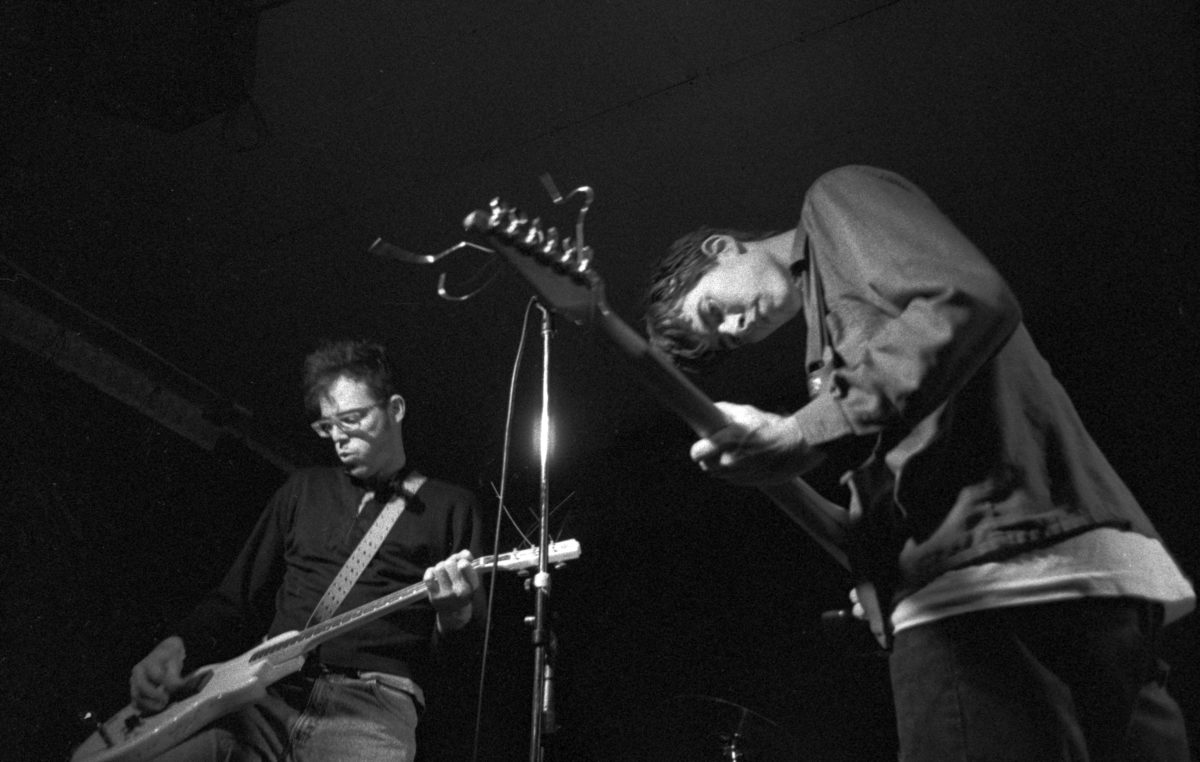
BILL CALLAHAN: I played Maxwell’s maybe four times if I had to guess. It was always good times. Small, loud stage. Positive crowds. I saw Palace play there once. I remember I walked into the show and the opening band (Anomoanon) were already playing. I saw Will (Oldham) at the soundboard and went up to say hi. We talked for a minute and then he said, “hold on,” and picked up a vocal mic and sang a backup line to the song Anomoanon were playing. There was a bartender named Alyssa Milano who was very good-natured about dumb jokes concerning her name.
M. WARD: I played a few shows at Maxwell’s when I first started playing the East Coast. It was always a sweaty, friendly scene. Always so packed that if you needed to walk somewhere you had to walk sideways. I played a couple times as an invitee of Yo La Tengo’s annual fundraiser. Always a blast. The stage was small but just right, and the backstage wasn’t a backstage, it was just a big basement that looked like one where Mr. Halloran taught Danny about the Shine. I remember Ira and Georgia from Yo La Tengo teaching me the chords to a lot of songs down there. As a grand finale, the masters taught me “Hunk Of Burning Love,” and then we were joined by an Elvis impersonator.
TIM HARRIS: Maxwell’s became a home base for us to bridge into the big city to play places like Danceteria, Trax, and Privates. It really served as a strategic jumping-off point for us nouveau punks to navigate the complexities of the Big Apple. We usually started our fourteen-hour drives back to Louisville from Maxwell’s after midnight. I remember seeing Pylon play there, and we left after the show. Vanessa Briscoe—rock hero, sweetheart, and eminent safety director—standing there by the jukebox, wishing us a safe drive home. She knew the drill. We charged $1 and handled the door ourselves. Ira Kaplan probably had to do the sound. This striking tall guy with a discerning intellectual mien approached me at the door; it turned out to be my later-friend Robert Sietsema, known now as a food critic, but then a member of the aptly named band Mofungo. He misread the price as $10 and asked if he could pay half-price since his band also played at Maxwell’s. And I said, sure, you can pay fifty cents, if you want to. We played two New Year’s Eves at Maxwell’s. The first was the BDB with the Human Switchboard in ‘81 and the second in ‘85, Antietam, with Hoboken’s Gutbank and the Golden Palominos.
ERIC SLICK: I remember being squashed into a corner onstage. Drummers often get the least amount of space when a venue is smaller. I remember my arms flailing and trying to play as fast as possible, all while smacking the red curtain behind me with my elbows. I felt like the crowd was standing on top of us. That always makes for a great show.
RACHEL BLUMBERG: The first time I played at Maxwell’s was on tour with The Decemberists in the early 2000s. I was thrilled to finally play there, as it was so legendary. It was so much smaller than I had imagined it, and it was a packed house that night. After we finished our last song, there was absolutely no where for us to go to do our regular, “Let’s tuck away and make a very dramatic entrance for our encore!” unless we wanted to crowd surf, so we hid behind our instruments, crouched and tucked to the floor, and then jumped out in a surprise way. Hilarious!
JAMES MERCER: For a band like The Shins, from Albuquerque, New Mexico, playing Maxwell’s meant that we were officially a real band in a lot of ways. We knew that so many great acts had played that stage. The thought that some great tendril had reached down and we had been invited to be a part of that world was thrilling. I remember how welcomed we felt eating in the front restaurant and drinking free beer. Looking around wondering where Yo La Tengo or Nirvana or The Replacements had sat when they surely did the same thing. During those early days, our lives were changing so quickly. So much is a blur. But not that first time at Maxwell’s. It was a singular moment and if that were as far as we had ever gotten, it would have been more than enough. I’m so glad we got to be a small piece of the history.
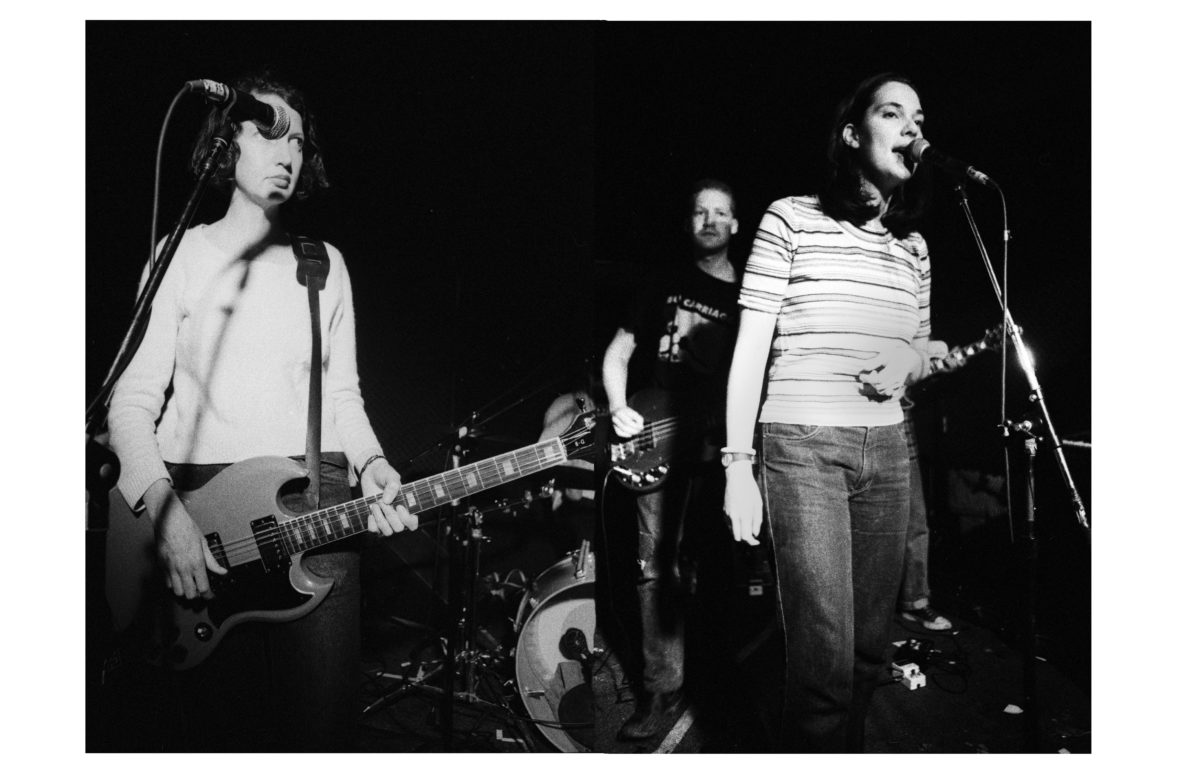
TARA KEY: We started playing at Maxwell’s in ‘81 as part of Louisville, Kentucky’s Babylon Dance Band, and it was a feature in the Village Voice, a cover story in fact, that gave us the key to the lock of getting NYC gigs. We heard that Maxwell’s was a must-play place and, with this entrée, we contacted the owner at the time, Steve Fallon, and got a gig playing with Love Tractor from Athens. It was March 20, 1981, when we first pulled up on 11th Street. I remember the smell of coffee. As we played more gigs, we met bands from the scene and gained fans, and that acceptance in the back room of Maxwell’s jump started our confidence and made everything since possible. And then, in ‘83, Tim and I decided to move north. We left the Dance Band, left Louisville to plant ourselves on Steve’s doorstep, figuratively, and he gave us the support we needed to set down new roots. He gave us a connection to Chris Stamey [of the dB’s] and to Water Music studio. We purchased a Scully 8-track machine to make our first serious recordings. One night in the first month we lived here, Fallon tried to play matchmaker. While we were idling by the jukebox, Steve introduced us to a couple by saying, “This is Tim and Tara. They are starting a band too.” Tim and Tara, meet Ira and Georgia. Steve gave us and another band making their debut a month of Sundays in November ‘84 to hone our respective crafts. That band was Yo La Tengo.
NATHAN MEANS: I can’t say that I was thrilled to be playing in Hoboken when I saw it on our itinerary. I’m not from New York, so I don’t think that the world suddenly ends when you cross a bridge or tunnel. It was more that The Cooler was the first “real” club that gave us a chance and paid us over $150. Then we moved over to other clubs like Brownies, but there was still the magic of being in New York and walking past CBGB or seeing famous musicians in the streets and the crush of people looking cool at some cool bar after the show. Even the dirty potholes filled with scummy water and gross detritus on sidewalks and getting yelled at by some dickhead has a cinematic quality to it—because it’s Manhattan. Two things changed my mind. One was that I heard that there was some Sonic Youth connection. They completely changed my understanding of what was possible with a rock band when I was about sixteen, so that made playing there more interesting. I don’t know if any of them showed up, so I’m gonna assume that they didn’t. Second, we arrived at Maxwell’s and it looked cool and was the right size and had a warm vibe and decor.
MATT LUKIN: I remember always having a great time at Maxwell’s. The staff and people in charge of the place were always welcoming and accommodating. So many good memories, but the quintessential memory must be the last time I was there. We played in Manhattan the night before and checked outta our hotel so we wouldn’t get charged for another day. With not much to do, we headed over to Hoboken in the early afternoon, grabbed sandwiches at a deli, then headed to Maxwell’s to load in. The restaurant wasn’t even open yet, but they were cool to serve us beer. We sat around drinking beer all day and evening. I don’t recall our set, but I remember after the show when it was mostly staff and friends and a few other scragglers hanging around. I started up with my silly move where I bend over and slap my back and bark out, “Get on my back!” Someone would jump on my back and I’d end up falling into people and spent more time on the floor than not. At one point, I jumped up on this platform about bar height over a basement stairway at the end of the bar. I started doing a striptease and ended up completely nude except my pants around my ankles. One of the staff told our tour manager that I need to get down from there ‘cause if a cop drives by and sees me through the window, we could get in trouble. It turned out okay. We were off and made it to the next show.
TAE WON YU: The long walk up Washington Street from the PATH. The late night wait for the PATH. The giant slices at Benny Tudino’s. Passing the “Hoboken Exterminating” shop window on Washington Street with their great logo. But once we got there, it was like settling in with old friends, between the trek to get there and the hominess of it being a normal restaurant and many of us coming in from NYC and folks from Jersey—it always felt like a reunion in a way.
CYNTHIA NELSON: It was the summer of ’93 and Ruby Falls was booking our first tour out of New York and into the South and Midwest. I had been listening to Royal Trux a lot and sort of entering their musical world. Their album Cats and Dogs had just come out and those dreamy lyrics seeped in and out of my head like smoke. Through Lyle Hysen (Keep Your Day Job Management; Das Damen), we got the opening slot for Royal Trux at Maxwell’s. I think we pushed our whole tour itinerary back to be able to play it in early September. When show day came, I was way too intimidated to talk to the headliners, but I was looking forward to having the “family dinner” special treatment. As it happened I was a jumpy bundle of nerves, wanting to play our best as usual but even more so. I was too worked up to even eat the dinner, much less bask in the experience. Also I had a personal rule that I only drank after our performance was completed, which meant that if I was uptight, I stayed uptight until we had delivered our music to the best of our ability. Our songs were intricate and complex, not lending themselves to gloriously sloppy versions. Also, as women, we felt a deep responsibility to summon our best musicianship at every turn. Likely, the show ended with one band member thinking it was our best performance ever and another thinking it was the worst, as was our custom.
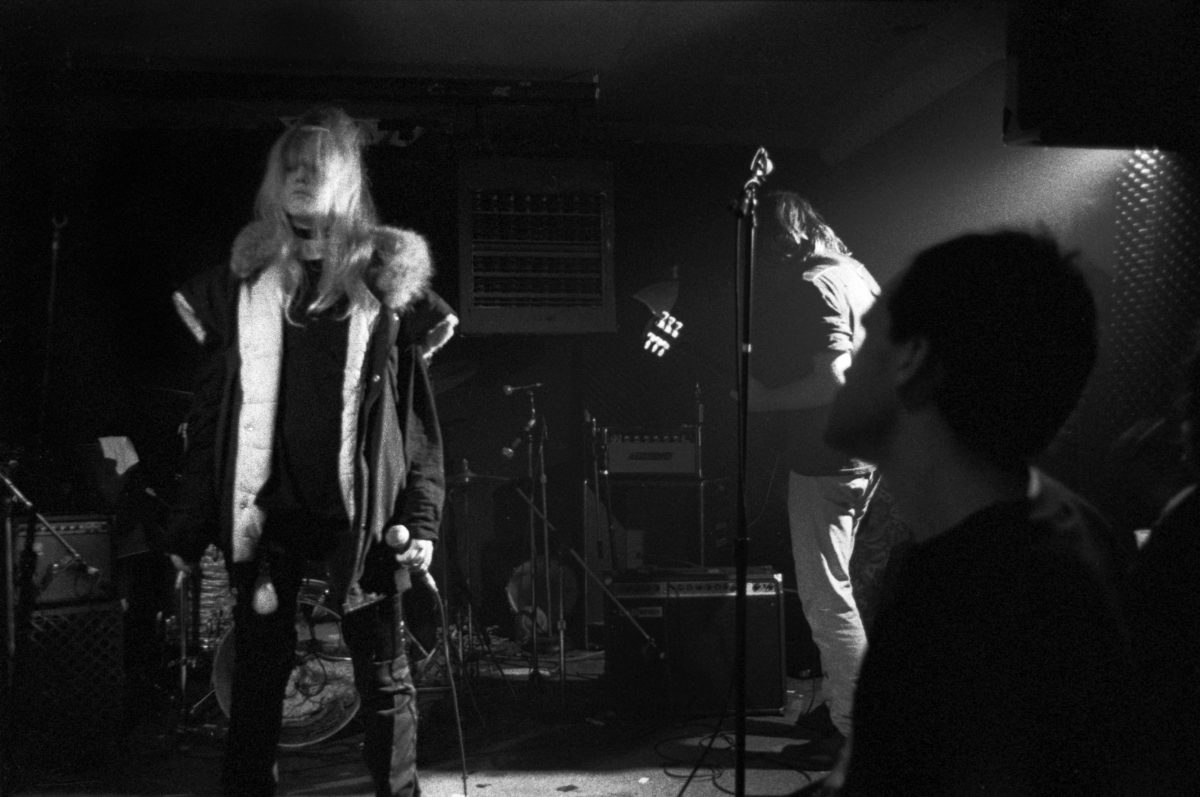
TED LEO: The Fugazi show in ‘88 when they had just really started asking people to not slam dance was amazingly powerful. It was tense and heavy; sweat was practically dripping off the walls. They were getting a lot of flack from people in the crowd, and when, during a quiet section of their song, “Suggestion,” the whole club breathing in and out like it was one humid lung, frontman Ian [MacKaye] began to speak over the music, saying something about “the next part” in the song, a kid heckled back, “Can we dance to this part?” and Ian replied “Why don’t you just listen for just one second!” The other thing that always comes to mind is the ‘91 Smashing Pumpkins show. I was, hilariously, offended by how loud it was, and I stormed outside, expecting at least a few of my friends to join me, but no one did. So I bought a pack of Camel’s from the cigarette machine and just stewed by the back windows amid the summer sewer smells.
NATHAN LARSON: There was a whole procedure to my Maxwell’s visits, and even from my earliest shows, I compulsively followed this routing: get singles for the trip, have a coconut Yoohoo and take the PATH train from 14th street (it was $1 forever!), make a half hour stop at Pier Platters, take the impossibly long trek up to the club, stop for a slice on the way to break up the journey, arrive at Maxwell’s approximately in time for sound check (mind you, I’m showing up as a civilian, not as a band member), eat something (generally, I would get fries because that was what I could afford; and I would need to get alcohol elsewhere—I remember carrying some beer in a bag thinking I was slick), enjoy the show, then drunk-walk back to the PATH station which was always vastly further than it seemed on the way.
DAVE DREIWITZ: My memory of Maxwell’s is that of a magical place that was part clubhouse, part music venue, part art gallery and a great pub! The staff and local patrons were a big family. I played there often with my band Tiny Lights beginning in ‘84 while still in high school and ended up getting a job there as a busboy in ‘89. The singer of Tiny Lights, Donna Hamilton, also worked there as a waitress.
RICHARD BAYULUT: Seeing Husker Du in ‘84 on the Zen Arcade tour. Lightning-fast set, the crowd was a seething mass of bouncing bodies. A blissful blur. I was eighteen years old.
BOB BERT: I’ve spent half of my life seeing shows and playing at Maxwell’s. I moved to Hoboken from NYC in January of ‘81 and always lived within two blocks of the place, still do—only now it’s a fancy seafood restaurant called something else. The day I moved to Hoboken, I went to Maxwell’s and saw a bill of the Bush Tetras and the Raybeats, two post-punk downtown NYC bands that both featured ex members of the No Wave band James Chance and the Contortions.
SARA JAFFE: It’s all about being a teen, driving down from Teaneck with my one friend I went to shows with, finding a place to park along that road and the water, knowing somehow it was cool to park there for shows despite the “No Parking” signs. The ultraviolet hand-stamp scanner. Waiting for the bathroom. Feeling so grown up.
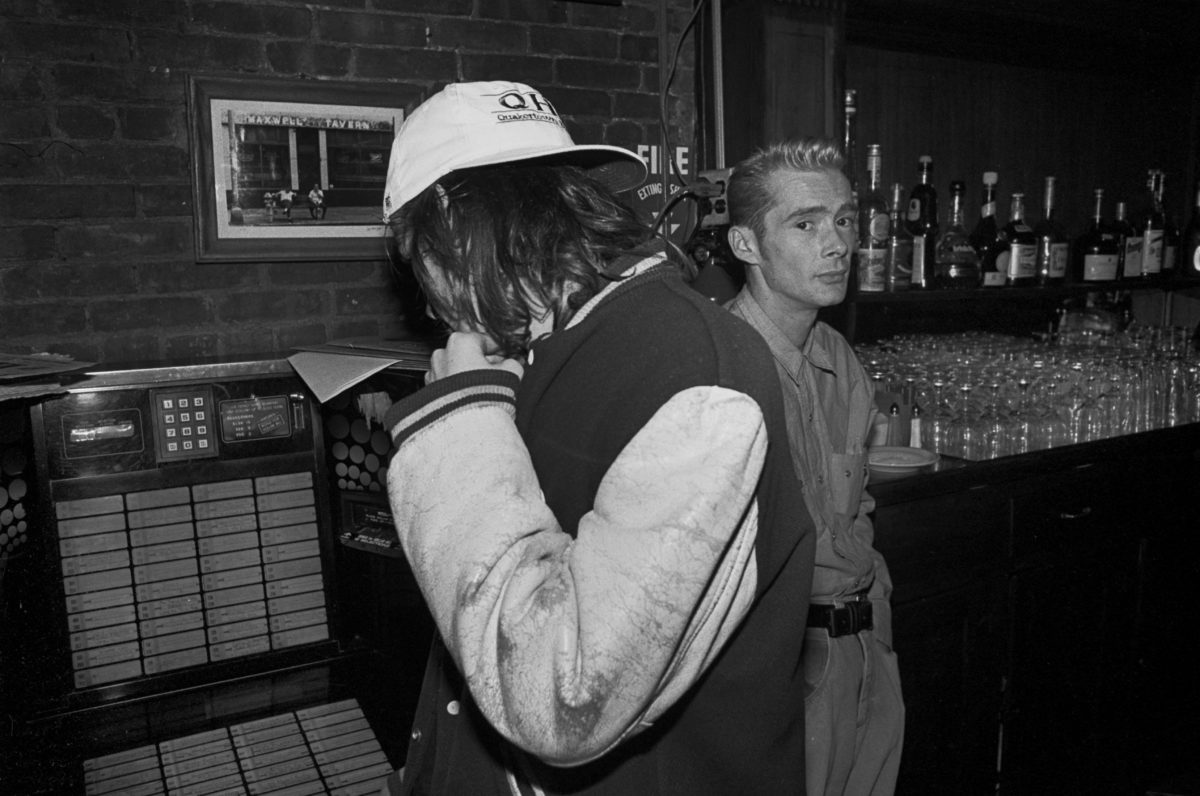
WOLF KNAPP: Working the door meant getting there early to set up so I heard a lot of sound checks and answered questions from the bands. It was a friendly place and I think the bands appreciated that. D. boon [Minutemen] asked where a band could stay. I offered my apartment after he said that the Super 8 was a little rich for them. We loaded out into the Econoline, drove down to 4th and Adams and carried guitars and D.’s Princeton upstairs to the apartment. We stayed up all night spinning Flatt & Scruggs. Minutemen took off just after sunrise for an afternoon gig in Hartford at 3 followed by a gig in Boston that night. Another great sound check was Bob Mould and Grant Hart jamming on “Reoccurring Dreams.”
JOE LALLY: Walking around Hoboken before the show and thinking about Frank Sinatra. My father grew up in Manhattan during the depression and as the location was so close I kind of saw things through his eyes, I guess. Knowing Sinatra was from Hoboken, I just thought about him too.
JULIANA BRIGHT: My band at the time, the Quails, would have been on tour for some weeks before we arrived. It was one of those shows you book to fill in the blanks on your tour, an early performance that would wrap up with time to spare before doors opened for the night’s “real” show. I don’t recall a particularly remarkable achievement on stage that evening, but it was almost always holy to fall into the rangy, noisy patois my band made. Maxwell’s, while clearly legendary, wasn’t particularly special in drawing this out of us. But I’m happy for the excuse to call forth that sun-lit, empty room from memory. And those young darlings I got to make noise with.
LYLE HYSEN: Standing by the jukebox, pint in one hand, gesturing with the other hand, as I talk to some of the best people I’ve ever met while seeing some of the best music I will ever see. Also, I had my younger daughter’s first birthday party there. And my older daughter, when she was in third grade, sang in a faux school choir opening for one of Yo La Tengo’s Hanukkah shows as a fundraiser for her school.
What specific shows do you remember?
STEPHEN MALKMUS: Laughing Hyenas, Nation of Ulysses, John Spencer, Helmet, Sebadoh, Thinking Fellers, Galaxie 500, Royal Trux, Love Child. Those Laughing Hyena shows were very dramatic—felt like everything was on the line. I’d like to feel that energy again.
BOB NASTANOVICH: Dinosaur, Mudhoney, The Jesus Lizard, Laughing Hyenas, Unrest, Scrawl, Die Kreuzen, Naked Raygun.
MATT SWEENEY: I saw so many shows there in the late 80s, jeez! Standouts off the top of my head:Sun Ra and Saccharine Trust, Dinosaur opening for Sonic Youth right before You’re Living All Over Me and Sister came out. My head exploded. Soul Asylum being undeniably godlike, around ‘86. Redd Kross on New Year’s Eve. Lots of Redd Kross shows there. Lydia Lunch laughing at my teenage crew’s offensive jokes and being nice to us. Big Stick!
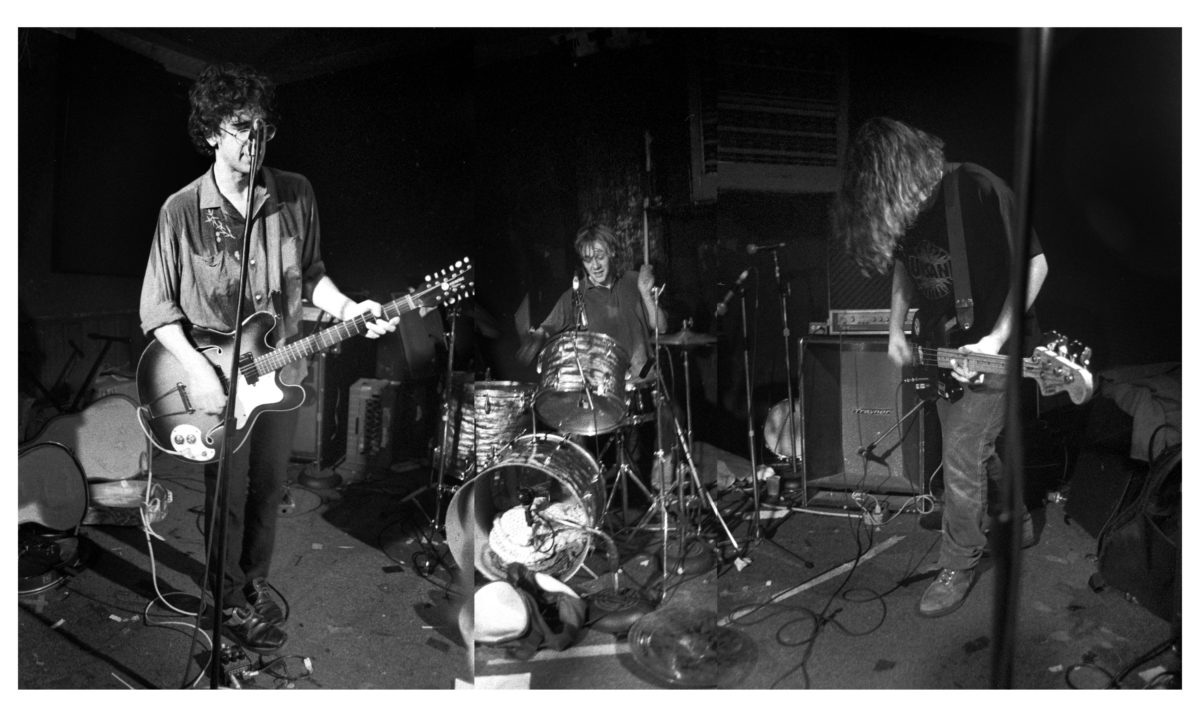
PHIL MANLEY: I remember playing Maxwell’s with Rye Coalition who were from that part of Jersey. The venue was totally packed, hot and sweaty as a rock show should be. Miss those days!
ERIC SLICK: A show with Adrian Belew in ’09. Adrian is a guitarist known for playing with Bowie and Talking Heads. I was part of his trio for three years before I joined Dr. Dog. I was twenty-two years old. We would often play B.B. King’s Blue’s Club in Times Square, and none of my young Brooklyn friends wanted to spend $150 on microwaved macaroni and cheese while sitting and watching my prog rock dreams come true. The food at Maxwell’s was far superior, so all of my friends came to support me. I was thrilled to play Maxwell’s. The show had a lot more energy than our previous area shows. The crowd was loud, the show was loud, and we felt like we had accomplished something that we couldn’t in the big city.
RACHEL BLUMBERG: The show that is the most memorable for me was in 2011, when I was one of the special guests for Yo La Tengo’s legendary Hanukkah shows. I sat in with them and drummed on a handful of songs when Georgia (Hubley) would move off the drums for keys or singing. It was such a wonderful experience to be there and play! I had always dreamt of attending and was thrilled they invited me. There was such a family feel, as is part of the genuine true nature of this band (who I love with all my heart). I went all eight nights and played on three of them as I recall. The scene in the cramped basement “green room” (aka storage room) was jovial and familial.
TARA KEY: We opened for Husker Du on December 29, 1984, and after our set, only six months after forming, Gerard Cosloy (Homestead Records) approached us to ask if we wanted to make a record for Homestead. It blows my mind now to look at the ad for shows in October-November ‘85. Sunday, October 27: Minutemen and Phantom Tollbooth. Thursday, October 31: Flies and Antietam. Friday, November 1: Billy Bragg and Yo La Tengo. Being there in that time was really like being at the molten core of things but it did not seem anything but normal. You don’t really know you are living through the making of a legend until it is in the rearview.
TAE WON YU: Galaxie 500, Fugazi, The Clean! But maybe the most momentous was the Beat Happening, Nation of Ulysses, Unrest show where Bratmobile stormed the stage before Nation of Ulysses, because it was the start of a lifelong friendship with all of them. Also Unwound’s first tour, where they played to me and the soundman and they stole pasta from the basement in lieu of no payment.
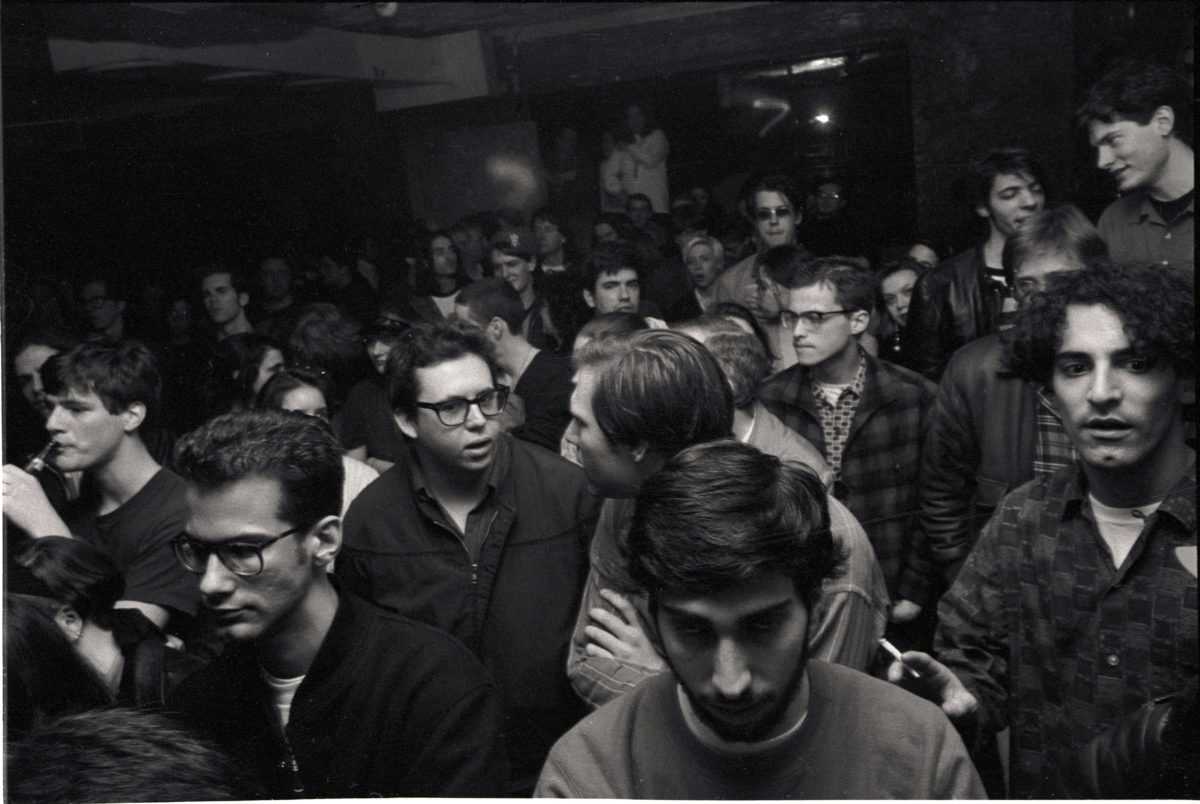
TED LEO: A stand out show for me was schoolmate Matt Sweeney’s Skunk with H.P. Zinker and Ween, probably’89. Mind-blowingly weird and rocking at the same time. Freeing, really—song craft, humor. And volume. Another standout, a couple of years later, was Helium during a blizzard. I met my own bandmate, James Canty, when the Nation of Ulysses played there in the summer of ‘90. I’d driven down to D.C. with Weehawken based Born Against for an outdoor daytime show they were supposed to play that got rained out, so their singer, Sam, and I decided to high-tail it back up to Jersey to catch the Ulysses show. When they started, their singer, Ian, leapt into the air with a cup of coffee and saucer in hand, throwing it skyward, and it all came down hard on drummer James’ head. He didn’t miss a beat, and we knew we’d made the right choice.
Also, I had a weird but important moment with the guitar player from the Afghan Whigs after a show they played there on the Congregation tour, wherein, after the club was mostly empty, I just paid him a compliment because I legit thought he played a great show, and he sat down and expressed that he felt awkward about it because he really didn’t think he’d had a great night, and we talked it out for a minute. It was nice for me to have that human interaction, but also important as a developing performer to get that perspective from someone I respected, and to understand that it’s not always going to be perfect, and you can examine why, but you also just have to live with it and accept that what’s happening for you isn’t always what’s happening for people in the audience. Among shows with Chisel, the Pharmacists, and solo, I’ve probably played there at least fifteen times. One of my best memories was a Chisel show with just immediately pre-stardom Everclear, after which one of the bartenders pulled me aside and said, “You were the only real rock band on stage tonight.” If nothing else, I can take that to my grave. It was also incredibly validating and bittersweet to be able to play one of the final shows at the club. It meant a lot to me to be asked, and that’s also something I’ll take to my grave.
NATHAN LARSON: As a fan and an audience member, there’s just a ridiculous number of fantastic shows I was lucky enough to be present for at Maxwell’s. The earliest of these in my memory being the Pixies (perhaps 88’ or 89’), though this could have been predated by a Sonic Youth gig. I feel like I saw them several times there over the years, or Black Flag.
DAVE DREIWITZ: Sun Ra and His Arkestra with a full big band including four drummers and a troupe of dancers. I don’t know how they fit all that on the little stage—that was part of the magic! Nancy Sinatra played there with Clem Burke of Blondie on drums and Gilby Clarke from Guns N’ Roses on guitar. A highlight was Jon Spencer sitting in on the Nancy/Frank Sinatra hit “Something Stupid.” The Replacements playing a last minute show while in New York for Saturday Night Live, because they just wanted to play on a night off! It was crazy. The Rollins Band played an incredible show there. It was at this show where I was introduced by the guys in the Rollins Band to Dean and Gene Ween. Little did I know at the time, Ween would eventually ask me to join the band, and I’m still a member! The Meat Puppets played an amazing show. I didn’t know their music that well, but I was impressed by Cris Kirkwood’s gigantic bass speaker (and huge bass sound!) that reached the ceiling. I’m not sure how they got that speaker into the venue.
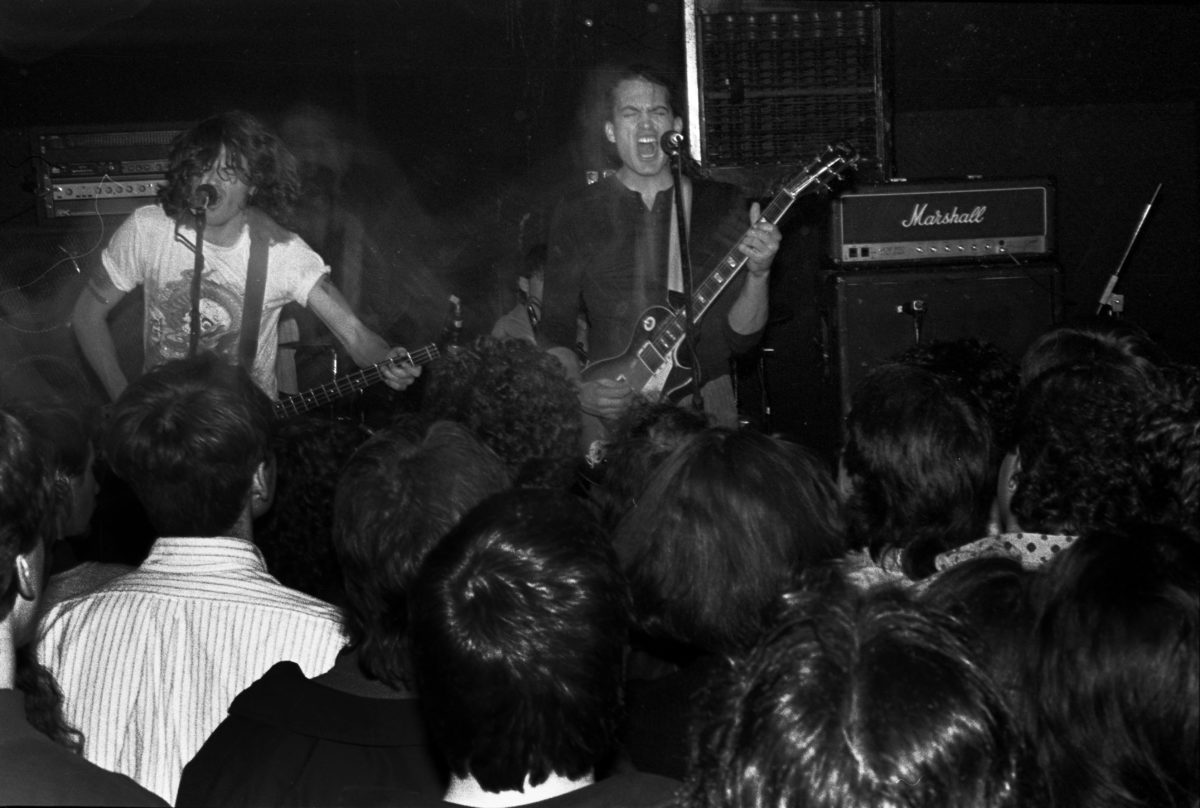
And Tiny Lights got our start opening for many local and touring bands until we began to headline our own shows there. We opened for poet Jim Carroll with Lenny Kaye on electric guitar, The Feelies, The Go Betweens, Soul Asylum, and many others. One show Tiny Lights headlined was with Lucinda Williams as the first opening act, then Sam Philips with T-Bone Burnet and Jerry Scheff, Elvis Presley’s legendary bass player, as the second act.
SARA JAFFE: ‘93-‘95: Concussion Ensemble, Geraldine Fibbers, That Dog, Slant 6 & The Makeup, Vitapup, Heavens to Betsy & Excuse 17, Guided By Voices (some of these might be made up).
JOE LALLY: The cover of the Fugazi self-titled EP was shot there by Adam Cohen. The inside sleeve is from the same show and almost the same moment shot by Glen Friedman. That’s pretty amazing if you think about how tight that space is.
LYLE HYSEN: The Replacements’ first time playing at Maxwell’s. A photo exists of me and Jesse Malin leaning against the stage.
Do you feel that Maxwell’s felt different from other venues of the era?
WILL OLDHAM: To me, a good experience at a venue (as a performer) should include some combination of a few key elements: there should be a bathroom easily accessible and exclusive to performers; there should be a space for performers to sit, unmolested, to watch the others acts on the bill do their thing; accessing the stage for our performance should be hassle-free. Other perks: good food, a vibrant neighborhood full of interesting shops, restaurants and sights, a good parking and load-in situation isolated somewhat from the comings-and-goings of the general public. Similar to Chicago’s Lounge Ax, Maxwell’s had none of these. And yet, similar to Lounge Ax, Maxwell’s was a place I always looked forward to playing and spending time at. If you were living or staying in NYC, getting to Maxwell’s could be a bitch. But something about the place was conducive to a strong musical experience.
BOB NASTANOVICH: They had their own scene and I’ve never been a part of a scene. I certainly wasn’t a part of that one but I was grateful that it existed. There was a reputable restaurant in the main part of the building. The crowds were knowledgeable and it had this tameness about it where the performance of the bands was definitely gonna be the most explosive part of an evening. Everything else was the calm before the storm, which happened on stage. The overall vibe had insecurity, snobbery, and timidity, and things seemed intelligent and well-appointed.
STEPHEN MALKMUS: It was the perfect small size. You could see music through the slats from the outside if it was sold out (or if you were broke). There was free rock ‘n’ roll on the sidewalk.
MATT SWEENEY: Maxwell’s was so classy without ever letting you know it was. The restaurant looked beautiful and old timey and felt eternal and cozy. The bands were always in a good mood because they got to eat a killer dinner and got treated like human beings. Also bands didn’t have to deal with the stress that comes with playing in NYC, so the feeling of the shows was just better. The audience came to dig the bands. The Maxwell’s audience had discerning taste but was enthusiastic and not snobby. The jukebox was fantastic. Everyone was somehow tolerant of us annoying kids.
ERIC SLICK: Not a lot of [combined restaurants and venues] end up feeling particularly fun or intimate. They usually smell like old food and vomit. Sometimes you walk in and the stench will attach to your skin for weeks. Maxwell’s had an air of class and history to me. You have to remember that I was young. Any time we played a venue I had heard about before the widespread usage of the internet—it felt like I was hitting the lottery.
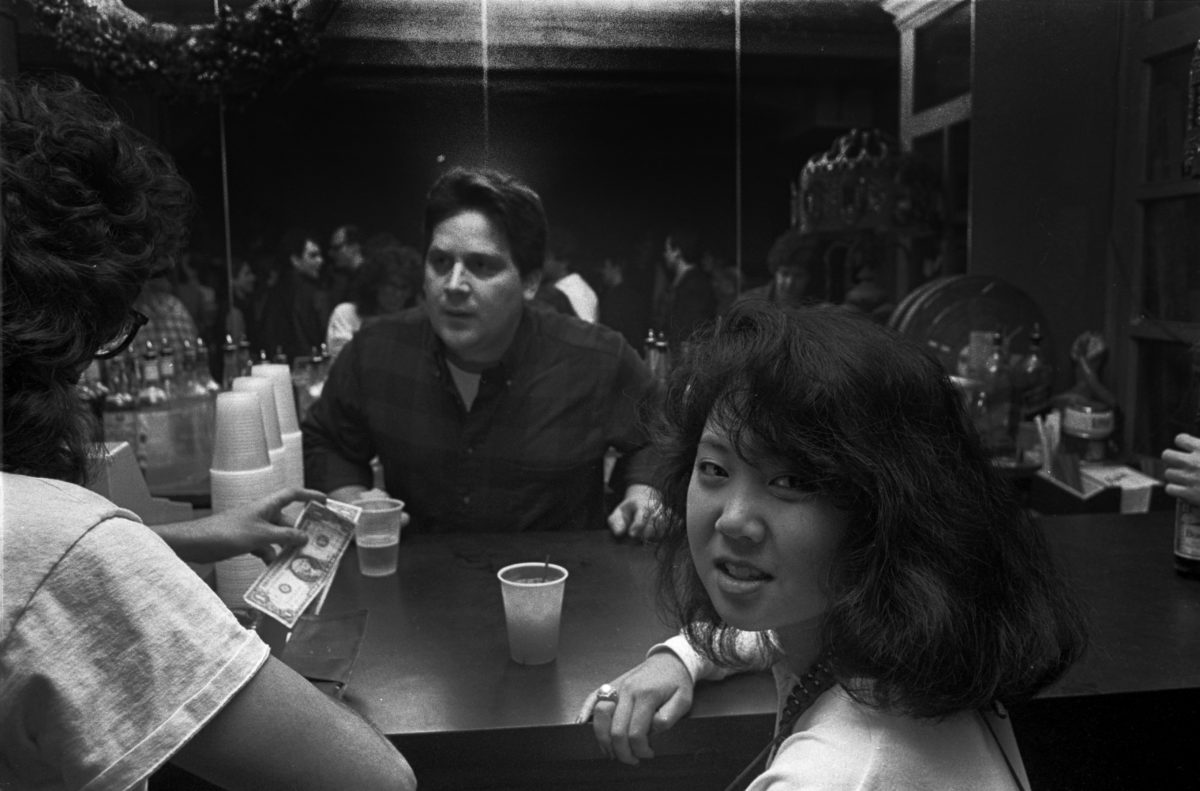
RACHEL BLUMBERG: Maxwell’s had a feeling of family. You could tell that the tendrils and roots of the community at Maxwell’s were deep and built up over time. The aesthetic nature of the place reinforced those feelings, since the live room was so small and the bar had such a beautiful, old timey vibe.
TARA KEY: It seemed almost anytime we walked into the club we would see a friend or meet someone who became one. Sure, you could go to shows in the city and there would be familiar faces, but there was something different about standing in the hallway by the phone with a John Courage deftly poured by Declan (my first “serious” beer, first sampled on the first trip), dodging Martha and other staff darting in and out of the kitchen. It felt like joint ownership of the psychic space. It felt like belonging.
Even after Steve ceded the club to Todd Abramson, this was the case. Todd was a great steward of the soul of Maxwell’s, and maintaining that for so many years was truly a feat. Most clubs are about transience, bands and fans passing through without investment, not leaving much of a mark beyond graffiti on a dressing room wall. Here you were stakeholders. You might drop in in the afternoon for a beer. Or come to see an art show. Or walk by and see a friend inside and drop in for a minute without even hitting the back room. If you played a gig, you got fed.
NATHAN MEANS: About 35% of being on tour is trucker logistics. Basically, you get paid to arrive on time with the cargo. It doesn’t matter how crappy your show is. So, saying that it was simply easier to deal with your van and gear at Maxwell’s vs. Manhattan doesn’t sound like that big of a deal to people who haven’t toured, but it can change the whole experience for everyone. On average, not driving around for hours looking for parking makes you have a better show. And hanging out in Manhattan at a bar at 1:00am just worrying about your van around the corner kinda sucks too.
BILL CALLAHAN: It had its own mystique. That you had to walk through a restaurant added to that. Almost like a Speakeasy. And that it was in Hoboken, which seemed like a way too small and quaint town to be so near Manhattan. Hoboken was like the land of the elves in my eyes.
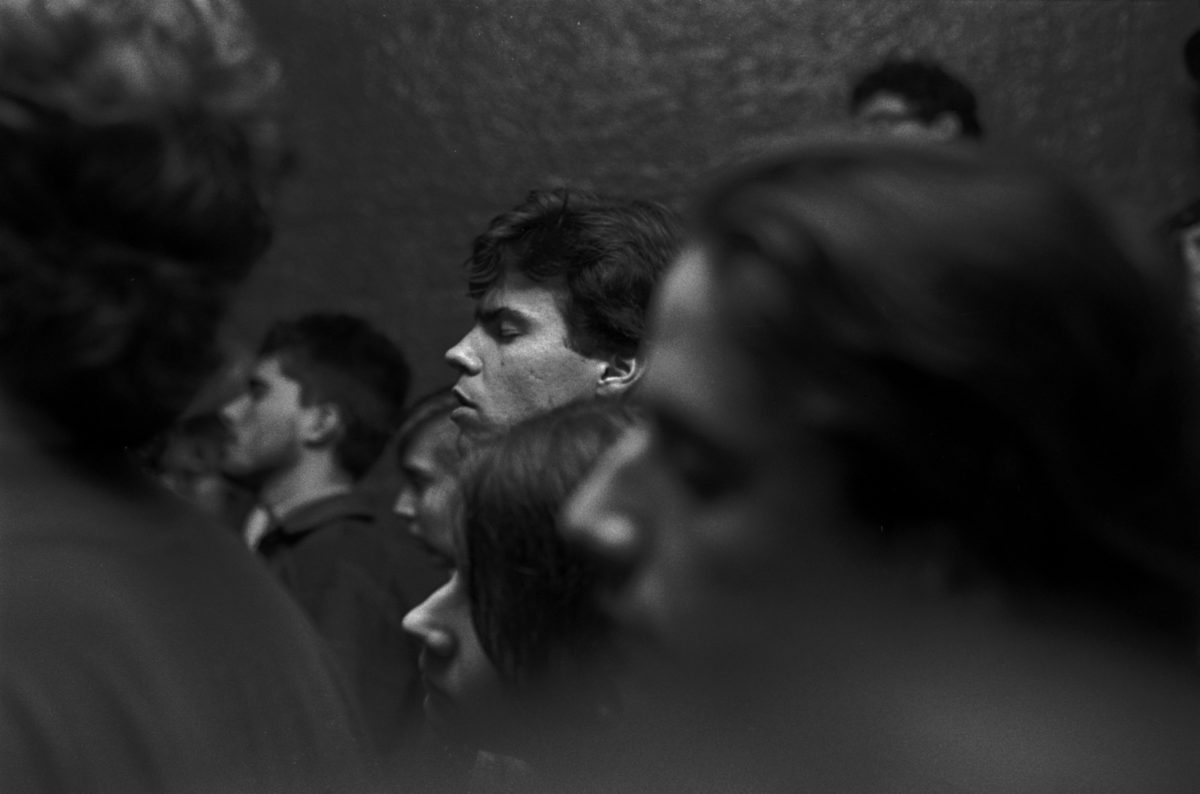
MICHAEL GALINSKY: It was such a great place to see bands because of the intimacy of the shows. The same band would often play a much bigger show in NYC, so it was often worth the trip to see bands in a small space. It was a small town club in a big city. If you went there more than a handful of times you ended up knowing half the people there.
TED LEO: The only place to hang out before and after they opened the show room was the restaurant and its bar. There was no other dark rock club bar to linger at, and that had a number of effects. It made the focus of the night the actual show. If you didn’t have a table and weren’t there to keep ordering, you didn’t have a ton of room to mill around. It was actually kind of awkward and frustrating, but also kind of cool in that it kept you focused on seeing the bands you were there to see that night. I guess something similar can be said about the live room, too. There was one bar at the back, and it was a pretty small club, so if you wanted to be up front, you had to get in, find your spot, and park it. Which brings me to the next point that can’t be overlooked—it was in New Jersey. I’ve always been frustrated by people who saw the Hudson River as some giant impediment to being part of the New York scene. There was something different and specific to being on that side of the Hudson. Maxwell’s had an aura of prestige around it, yet it felt somehow removed from the circuit—from the game of people trying to get noticed—and it felt very Jersey. It was where I’d see all the people I knew from Jersey who were still in Jersey. When you walked along the waterfront and smelled the coffee that was still being roasted, that was pretty magical, and it left its mark on you.
NATHAN LARSON: [It was] an aspirational spot, like I remember eating this kinda fancy gastropub cuisine in an era that kind of predated such stuff. Certainly this was rare in a venue in the New York metro area.
RICHARD BAYULUT: It wasn’t CBGB’s or a bombed-out basement in an abandoned building. It was almost suburban compared to NYC. Later, when Versus started to play there, they were nicer than other clubs and gave us food.
BOB BERT: It was an intimate space with a capacity of 200. Steve Fallon and then later, Todd Abramson (former owners) were real music lovers, so the bands were treated great, given free meals and a fair cut of the door. Plus if you were not digging aband you could just take a few steps into the dining area where there was always a jukebox loaded with great music. I became a musician living in Hoboken and have been touring the world ever since. It was always a pleasure coming home and going back there, my home away from home.
SARA JAFFE: It was really my first venue. It was amazing and distinctive that some shows were all ages—pretty much the only other all-ages shows I knew of were hardcore shows at VFW halls and stuff (not really my scene), or bigger venues like Irving Plaza or Roseland (not as fun).
WOLF KNAPP: There really was almost no bullshit with people trying to bum-rush a show. I only remember people getting bounced a couple of times. Playing Maxwell’s was kind of like playing in your own living room, in a good way. We would close the bar at 4AM and meet again at noon for softball. And then head to Maxwell’s for a Bloody Mary. To me, Maxwell’s felt like it had all the musical generosity of CBGB with an extra side of human generosity. More than any specific show, it was seeing great shows week after week. Amazing.
LYLE HYSEN: Hoboken, at one time, had the trifecta of rock going on: record store, music venue, and cheap places to live and practice. I could walk to Maxwell’s from anywhere I lived in Hoboken. Can’t say that about any other important major venue, ever.
What do you think made Maxwell’s unique?
MATT SWEENEY: Steve Fallon (original owner). He was so cool. He let my obnoxious high school band rehearse there so our friend could try and learn how to do sound on the PA. Teenage Maurice Menares doing the door and mocking literally everyone was a fresh vibe. It’s hard to say because as a New Jersey high school kid, it was essentially my local venue so it was what I was used to. I didn’t realize just how good we had it. I feel like I went to school there. In fact, I really did.
BILL CALLAHAN: The location. And the fact that it was near the cultural capital of the world but had a natural cap—only certain people would come to Maxwell’s. The people that liked it, loved it, I think.
NATHAN MEANS: Hoboken was sort of like Manhattan for adults. That still sounds super lame to me and I’m totally old now, but you can’t slum around rock boxes like Brownie’s forever. Of course, Williamsburg happened not too long after we played Maxwell’s, which sort of offered a combination of Manhattan and Hoboken. But I can imagine we would have been requesting to play Maxwell’s over Manhattan by the 2000s.
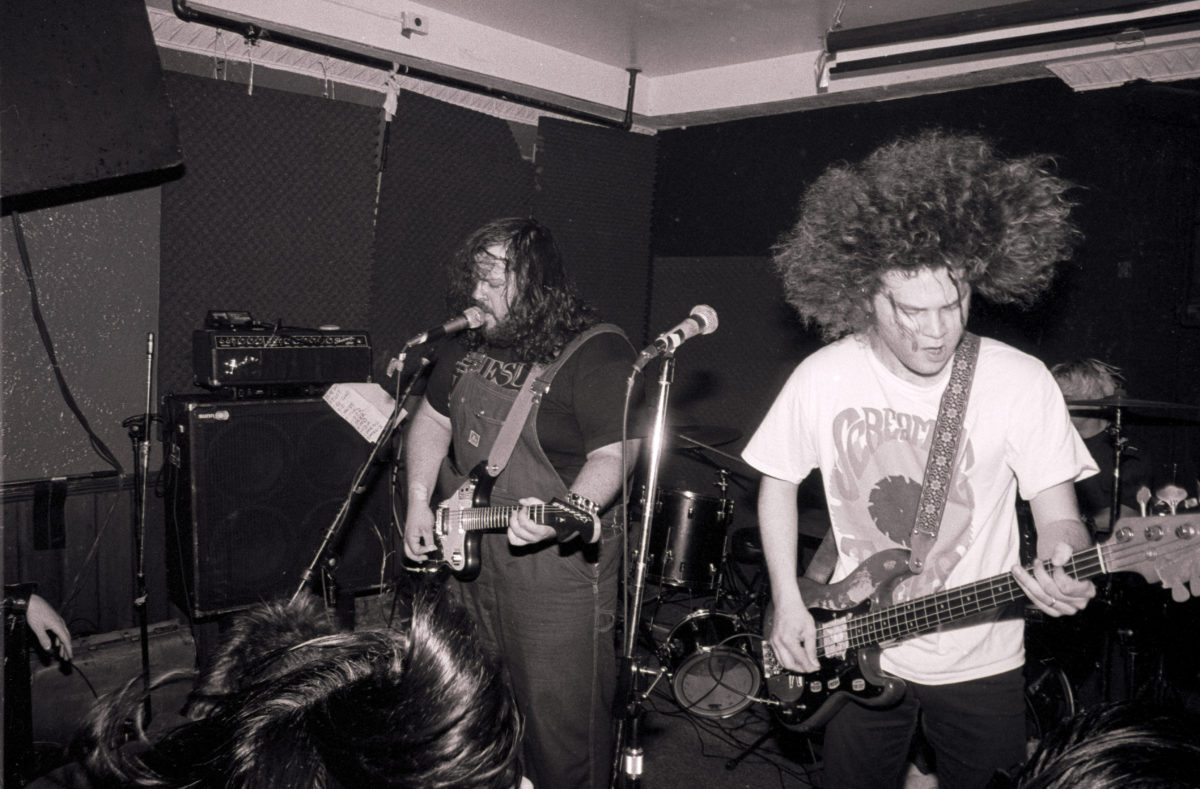
ERIC SLICK: I think they probably felt like they had something to prove, being in Hoboken. It was a great alternative to the gargantuan and corporate venues we had been playing in New York. The Adrian Belew Trio loved playing in smaller, packed rooms. In fact, so do a lot of bands. You give up dynamics, sensitivity, and a true audience connection when you play a stadium. It matters a lot less. At Maxwell’s, you could make eye contact with someone in the front row and be reminded of the humanity of performance. It’s so vital to removing your ego from the process. As much as possible, anyway.
TAE WON YU: There seemed to be a concentrated energy, the people running it and the fans that congregated there seemed to be really intense about music, less of a chance of the casual looky-loos stepping off the street perhaps, but the feeling of fandom was palpable in many of the shows I saw there.
If you could go back in time to a specific show that you either played or saw, what would show would that be (and why)?
WILL OLDHAM: All of them.
MATT SWEENEY: I guess Sun Ra and Saccharine Trust.
ERIC SLICK: Probably the Palace and Smog show in October,’95. I’m a sucker for all things Drag City. I’d probably pay $500 for that ticket now. Or any Husker Du show.
RACHEL BLUMBERG: In addition to playing at Maxwell’s with The Decemberists, I played there with M. Ward and I think I may have played there with Laura Veirs and also Mirah, if memory serves correctly? But, if I could go back in time to a specific show, it would absolutely be the Yo La Tengo Hanukkah shows. I’d go with my “now” self, do it all over again, but pay more attention, be more present with everyone, and enjoy every second of playing, listening and watching!
TAE WON YU: I would love to see The Clean’s first show again. It was their first time in America and we were all fans of Flying Nun but the possibility of seeing any of those bands seemed so remote back then. I was on the fence about going and Mike McGonigal, as he often does, convinced me through his sheer enthusiasm. I didn’t know what to expect but it was one of the best shows ever, every song was effortlessly brilliant. After going to shows regularly expectations become rote after a while, but this show felt like a blast of sunshine, and it’s one of my favorite memories.
RICHARD BAYULUT: When a box of Versus’ first 7″s arrived while we were playing. I’d like to see our faces when that happened.
BOB BERT: Hmm, that’s tough! I played there the first time in ‘82 with Sonic Youth and there were like five people there. I also played there a bunch with Pussy Galore, Bewitched, Action Swingers, Chrome Cranks, Knowville Girls. In 2011, Yo La Tengo managed to get Pussy Galore back together for one of their Hanukkah shows. This was a very special night and probably the one I would go back to.
SARA JAFFE: I think I’d go back to see Slant 6 again—didn’t really get what the big deal was at the time, but now I know they’re amazing.
LYLE HYSEN: Das Damen played Maxwell’s several times; some shows were better than others. And of course we blew the power at least once. The back of the first Das Damen record is a live picture from Maxwell’s. I can’t remember anything else about that show so I’d like to replay that one. I played Maxwell’s twice with Arthur Lee (Love)—those were magical.




